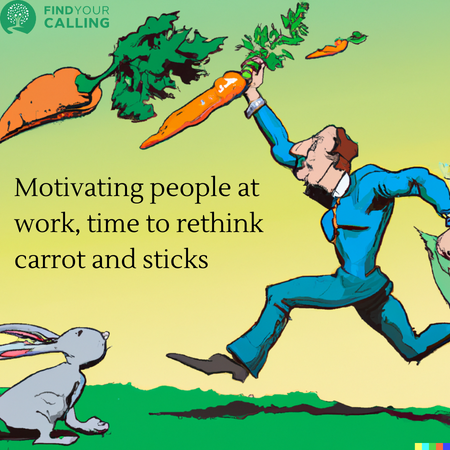We’ve covered how people are motivated at work in previous posts. External things that happen as a result of work (Salary, perks, recognition) drive some people, whilst the satisfaction of the work itself guides others. See “Jobs, Careers and Callings” and “How to harness true inner direction and ignore ego-driven goals”.
So I was keen to read Daniel H. Pink’s 2009 book “Drive – the surprising truth about what motivates us”.
Book Review: Drive by Daniel H. Pink
- In a nutshell: Businesses need to rethink how they motivate teams.
- Premise: From the book blurb – “When it comes to motivation, there’s a gap between what science knows and what business does. Our current business operating system – which is built around external, carrot-and-stick motivation – doesn’t work and often does harm. We need an upgrade, and the science shows the way. The new approach has three essential elements (1) Autonomy – the desire to direct their own lives (2) Mastery – The urge to get better and better at something and (3) Purpose – the yearning to do what we do in the service of something larger than ourselves”.
Autonomy, Mastery and Purpose

First of all, it’s worth noting that Daniel’s work is easy listening. It is a good balance between exploring science and storytelling with great recaps and valuable resources to explore the concepts in the book further – for yourself individually or as a business leader.
The book’s premise is founded on ‘self-determination’ theory by Deci and Ryan.
Self-determination theory looks at human motivation and says it’s not all about carrots and sticks. It suggests people have three basic psychological needs: autonomy, competence, and relatedness. Autonomy is the need to feel in control of our own lives and decisions, competence is the need to feel adequate and capable in our actions, and relatedness is the need to feel connected to others.
According to this theory, people are more likely to feel motivated, engaged, and fulfilled when these needs are satisfied. On the other hand, when these needs are not met, people may feel demotivated, disengaged, and unfulfilled.
Giving team members autonomy, opportunities for mastery and connectedness is in direct contrast to how most businesses motivate their staff, relying on good old fashioned “if this, then” extrinsic consequences, Daniel eloquently explains:
“Human beings have an innate drive to be autonomous, self-determined and connected to one another. When that drive is liberated, people achieve more and live richer lives. Autonomous people working toward mastery perform at very high levels. But those who do so in service of some greater objective can achieve even more.”
Type X & Type I
Daniel explains the two types of motivating staff via Type X and Type I.
- Type X – Motivated by extrinsic desires and rewards
- Type I – Motivated by intrinsic desires
As with any model, nobody falls into one of these two camps perfectly:
“I don’t mean to say that Type X people always neglect the inherent enjoyment of what they do or that Type I people resist outside goodies of any kind. But for type X the main motivator is external rewards. Any deeper satisfaction is welcomed but secondary for type I’s. The main motivator is the freedom, the challenge and purpose of the undertaking itself and other gains are welcome, but mainly as a bonus.”
Benefits of Type I
According to this Type I / Type X approach:
- Type I consistently outperform Type X in the long run.
- Type I is made, not born – People gain their Type I motivation from things that happen to them and circumstances. Age, gender or race are irrelevant.
- Anyone that is a Type X can become Type I
- Type I motivation is a renewable resource (Referred to as the sun) instead of Type X (referred to as Coal) – which becomes increasingly more difficult to sustain as external rewards become more and more extravagant to motivate people.
- Type I is associated with higher self-esteem, better interpersonal relationships and greater physical and mental well-being.
What is the source of a sense of calling?
I like Daniel H. Pink’s approach to all of this. I’m trying to think how it ties back to finding a calling, which is also intrinsically driven. Suppose Type I motivation stems from specific life experiences or circumstances, as Daniel suggests. Could those scenarios be fabricated, like an apprenticeship, to aid people in finding intrinsic motivation?
It reminded me of a quote from Paul Millerd in the Pathless Path, when he cited philosopher Andrew Taggart:
“The philosopher Andrew Taggart believes that crisis moments lead to “existential openings” that force us to grapple with the deepest questions about life. He argues there are two typical ways this happens. One is the “way of loss,” when things that matter are taken from us, such as loved ones, our health, or a job. The other path is the “way of wonderment,” when we are faced with moments of undeniable awe and inspiration.”
Much like an intern rotated through departments in a company to determine their strengths or interest in particular functions, could there be a way to shortcut the process from Type X to Type I, or could anyone make that leap with good self-exploration? Let me know what you think in the comments.
Image Credit: https://openai.com/dall-e-2/


0 comments on “Motivating people at work, time to rethink carrots and sticks”